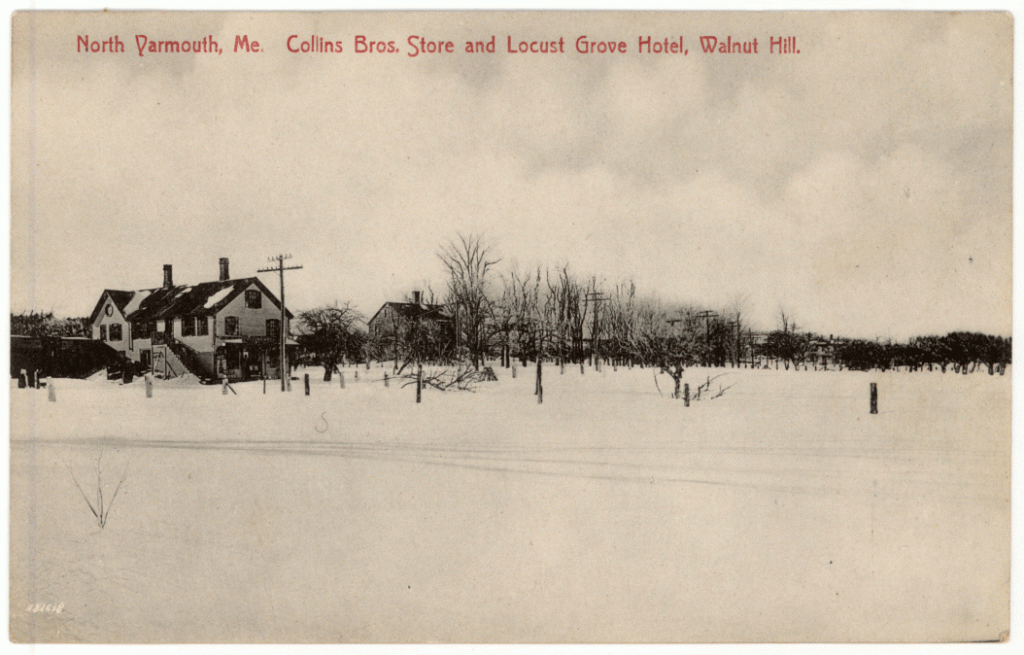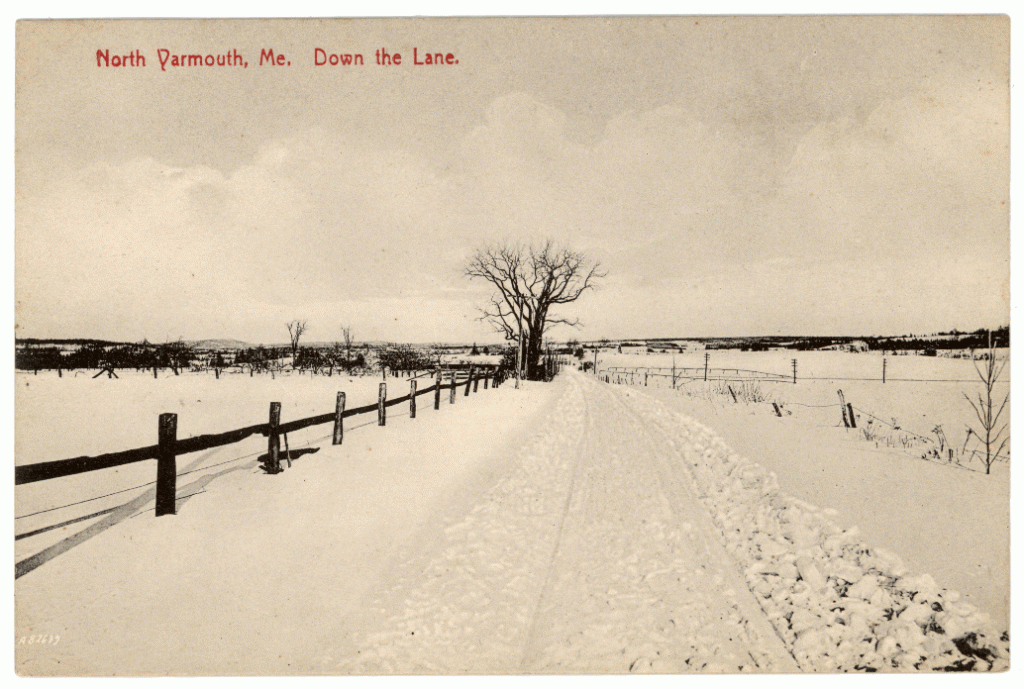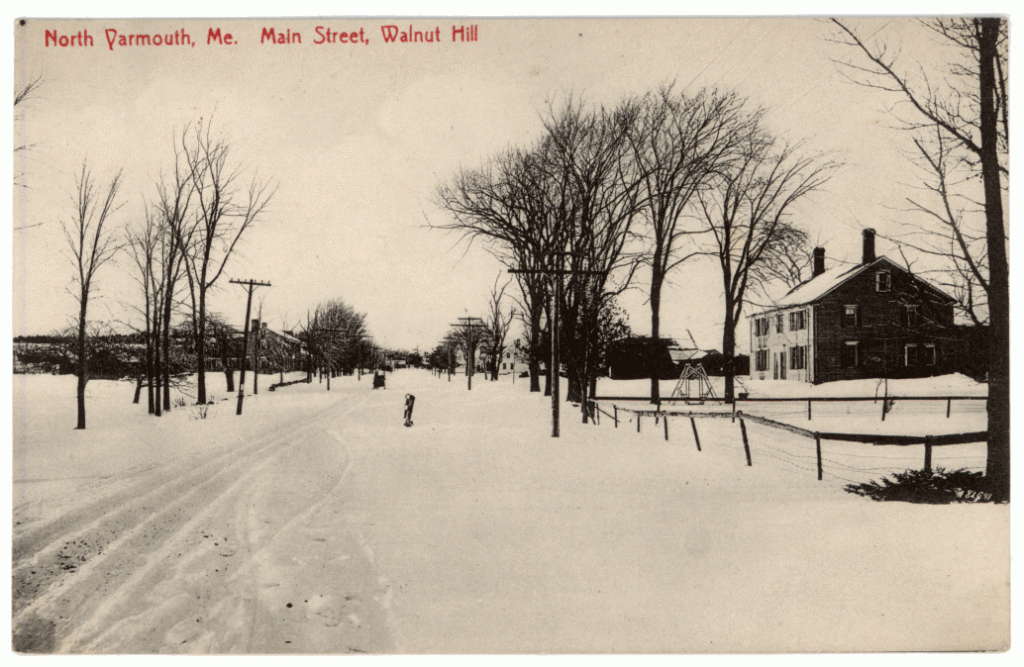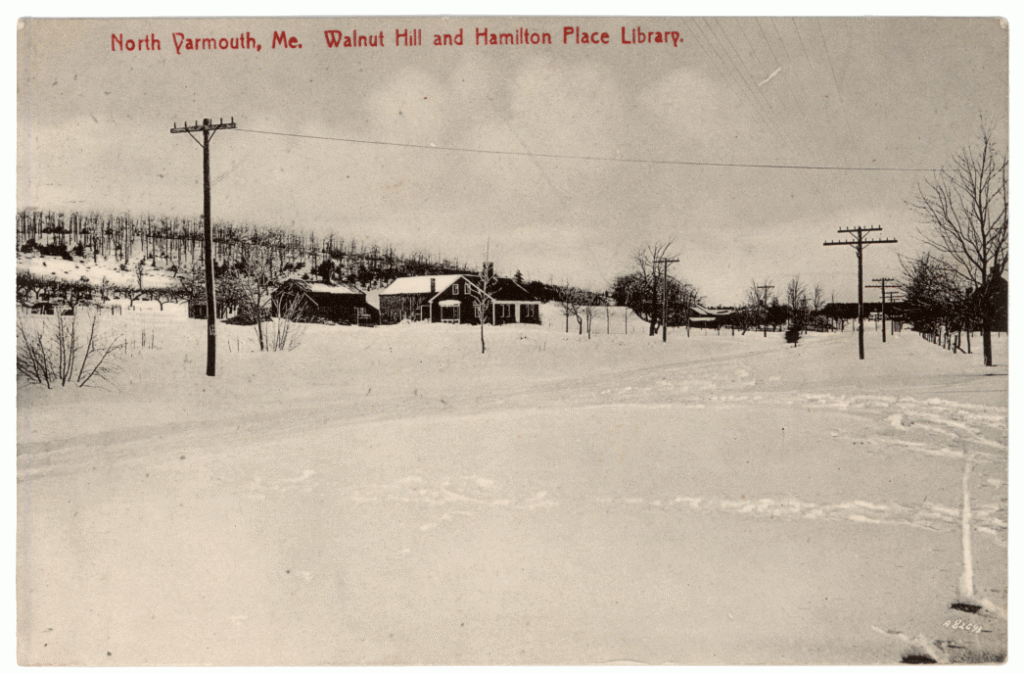
Do you like poking through flea markets or second-hand stores? If so, keep an eye out for some really interesting “moment in time” 1910 postcards of North Yarmouth. It’s exciting to come across these little treasures!
There are nine cards, produced by resident Henry H. York. We think he probably hired a photographer to shoot the stark winter scenes—because from the looks of each photo, the camera used had a nice wide-angle lens, the kind that an amateur photographer would not have owned.

At the time, 35-year-old Henry was doing a variety of things to earn a living. He owned a general store next the Maine Central Railroad depot in Walnut Hill; according to an old bill Henry was a “dealer in Grain, Groceries, Flour, Shingles and Coal.” He also worked for the MCRR. He and his family ran a dairy farm; he did business with the town for the occasional purchase of tools or other small items. Later in life, he painted houses, served as the Walnut Hill postmaster, and was the North Yarmouth Town Clerk from 1940 to 1946.
And in 1910, in a burst of entrepreneurial spirit, he produced this series of postcards of local scenes. It was a good time to give it a try. For several reasons.
A dozen years earlier, in 1898, the U.S. Post Office had set a reduced rate of 1¢ to send privately printed postcards. Talk was cheap at a penny each! BUT the entire back side of a postcard was reserved for the address only and any message the sender wanted to write had to be on the image, or front side of the card. However, in 1907, the law changed to allow messages on the address side of the card and the “divided back” postcard format we know today was then established and picture postcards became instantly more popular.
 And people were crazy for photography. Amateur shutterbugs could snap pictures and ship their camera to Eastman Kodak, who would develop the photos for 10¢ each, print them on manufactured postcard paper, reload the camera, and send everything back. Didn’t own a camera? No worries. Itinerant photographers traveled around to homes and businesses, made exposures, and returned later with photographs, often printed with postcard backs.
And people were crazy for photography. Amateur shutterbugs could snap pictures and ship their camera to Eastman Kodak, who would develop the photos for 10¢ each, print them on manufactured postcard paper, reload the camera, and send everything back. Didn’t own a camera? No worries. Itinerant photographers traveled around to homes and businesses, made exposures, and returned later with photographs, often printed with postcard backs.
Many early cards, including Henry’s, were printed in Germany, where lithography was more advanced than in the U.S. (By WWI, the threat of war and high import tariffs brought an end to the importation of German cards.)
Also in 1898 the U.S. Post Office initiated Rural Free Delivery—RFD—meaning that mail would be delivered door-to-door in any community of farmers who petitioned their congressional representative for it. Up until then, free delivery was only available to towns or cities of 10,000 or more; rural people had to go to the nearest post office to pick up their mail.

So, by 1910 it was possible to spend a penny to send a picture postcard on a Thursday to invite friends to a Saturday night social. A mail carrier would efficiently deliver it the next day, and the picture and message would be enjoyed. These little postals were good business.
Henry must arranged to purchase a package deal—photography and manufacture of his cards. The photographer probably came by train to the Walnut Hill depot to be met by Henry. And then they set out to make pictures.
Based on the sequence of numbers on the back of each of the nine cards, it seems that they started by making the first exposure (#33054) at York’s Store—of course.

Next, they walked out onto the Portland Road (Route 9) and took a northerly view of Main Street.

At that point it must have been midday, time to drive home for dinner, because the next view was taken looking down on Henry’s house from a rise above the York farm.

Dinner over, they headed back to the middle of town. First they took a nice a view of Collins Store …

… then walked down The Lane a ways and made a picture looking up toward today’s Skyline Farm.

They headed back for a view of the church and vestry … took two more photos of houses on Main Street …



and finally made a picture of Walnut Hill sloping down to the apple orchard behind Lura Hamilton’s combination house and Library.

The postcards were moderately successful but they didn’t exactly sell out; years later, Henry’s widow Asenath York, who took over his job as Town Clerk when he died in 1946, was still using the leftover stock. “Thought I’d remind you its time to license your dog. You used to do it early,” she reminded H.M. Lawrence in 1963, using a Collins Bros. store scene, long after Collins had sold out.
Henry’s granddaughter Ruth contributed some of the leftover cards to NYHS. One stack is complete with tissue paper “slip sheets” that prevented ink on one card from offsetting onto the next when the stack of cards were cut.
In 1911 the post office was relocated to the York home at 83 Gray Road—a story for another time. There, you could stop to register your car … look at a Town Report … buy a stamp … and, certainly, buy a North Yarmouth picture postcard and mail it right there.
These days, two of these collectible nine cards—the Church view and the Pumpkin Hill view—are rarer than others. If you spot one, remember that the originals are imprinted with red ink; the postcards with black type are reproductions printed in 1980 by NYHS in honor of the town’s Tricentennial.